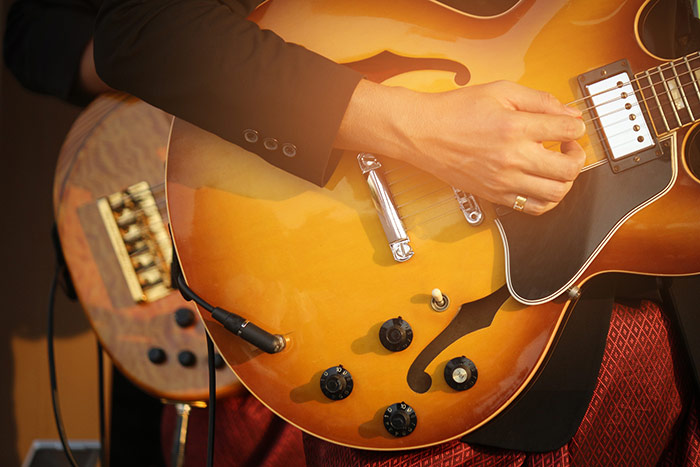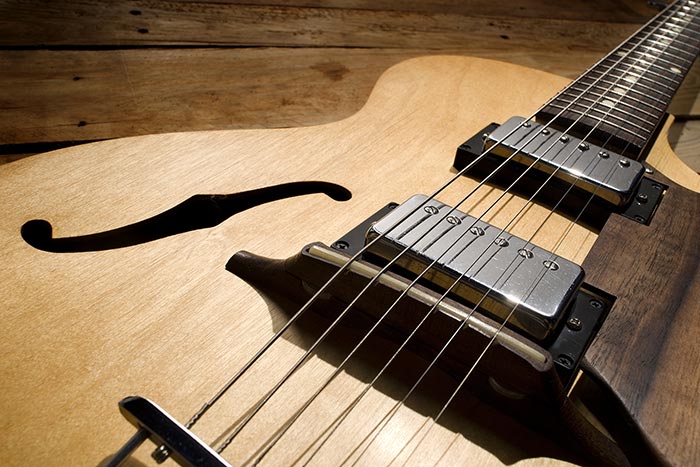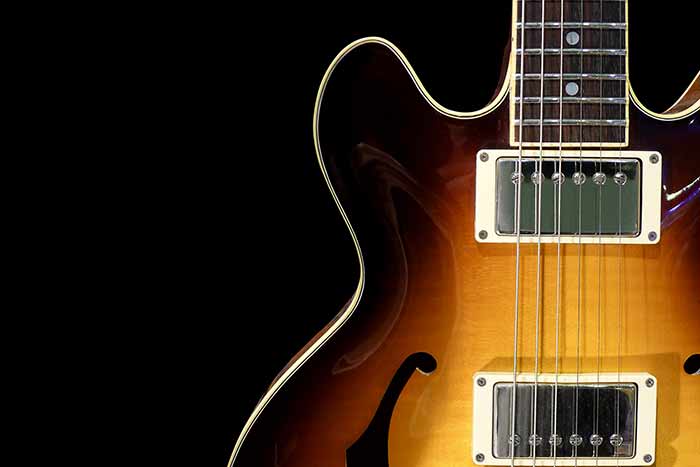Are you ready to increase your jazz guitar chord skills but don’t know where to start? Or maybe you’ve already tried but don’t quite understand the theory behind what you’re playing? Follow these crucial steps to get started on your jazz guitar chord journey.
Think about the degrees of the major scale
Ok so before you google “jazz guitar chords” and start trying to memorise a bunch of chord shapes on the guitar neck, let’s take a step back and think about the bigger picture. I’m a big advocate for understanding the theory behind what you’re playing since if you know exactly what you are playing, this will allow you to apply the same thing in different keys over different songs.
The core of a lot of music theory will always come back to one thing: the Major scale. This is the scale that the majority of chords and melodies are made up of, or at least referred back to when talking about which notes you need to alter in order to make a certain chord, etc.
If you don’t already know the major scale, I would recommend learning this thoroughly across the guitar neck, thinking about the degrees of the scale as you play them (1-2-3-4-5-6-7, 1-2-3-4-5-6-7.. etc.) rather than fret numbers. This will then help you to identify which note in the chord that you are learning is which and which notes we will need to change to make up the desired chord. Due to the nature of the stringing on the guitar, we will often be playing at least two octaves of the major scale in each position, so count through 1-7 before starting back at the tonic (1).

7th chords
Having this fundamental knowledge of the major scale across the guitar neck will be crucial to learning the first step of jazz guitar chords for beginners, which really starts at the seventh chords. These chords comprise four different notes, some coming straight from the Major scale and some being altered slightly from the original Major scale. The four main chords to think about when you are first starting out on your jazz guitar chord journey are major 7th, dominant 7th, minor 7th, and minor 7th (b5). Each chord is made up of the following formulas (degrees of the Major scale):
Major 7: 1 – 3 – 5 – 7
Dominant 7: 1 – 3 – 5 – b7
Minor 7: 1 – b3 – 5 – b7
Minor 7b5: 1 – b3 – b5 – b7
There are many common barre chord shapes for these chords, which is a great place to start, although instead of simply just memorising the shapes, try to think about which notes you are playing from the Major scale. e.g. C maj 7 (rt. 5) is played in the following order: 1 – 5 – 7 – 3 – 5.

Move away from barre chords and towards “jazz chords”
So, it will take a bit of time to get super comfortable learning those common seventh-chord shapes, and I would always recommend learning a few different tunes to learn them in context. That will be important to hearing their function in the context of a real song and also give you something to relate back to. A few jazz standards that will use these chords include “Autumn Leaves”, “All The Things You Are”, and “All Of Me”. If you’re after some more pop/contemporary examples, try learning “Sunday Morning” by Maroon 5 and “Painkiller” by Ruel.
But once we feel like we’ve gotten pretty confident with those barre chords, let’s try slimming them down a little bit to just the notes that we really need. The downside to those barre chord shapes is that they’re quite blocky and chunky sounding, often doubling up the same scale degree in different octaves. By slimming down the chord to the notes that we really need and not more than once per degree, we can create a more stripped-back sound, which will leave more room for the soloist to choose what sort of colours they want to convey in their improvisations (another big thing in jazz!).
The main notes that we will need in the chord are the 3rd (this dictates whether the chord is major or minor) and the 7th (this will affect the overall quality of the chord). Notice how I didn’t say the tonic (1)?! Well, often in jazz, you may be playing with a bass player whose job will mostly revolve around playing the tonics of each chord, so if they’ve already got that covered, why should you have to worry about it? We are trying to strip things back anyways! With them playing the tonic and you playing the 3rd and 7th, this will give the soloist enough harmonic context to play over. The 5th isn’t overly important as this doesn’t contribute to the overall quality of the chord; it’s more just reinforcing what is already there. You may decide to put this in when a chord feels a little empty, but it can be the first to go when the chord feels too full.

Passing chords
A great way to spice up your jazz guitar chord playing will be the use of passing chords, which will create a short moment of tension and release. The tension can be achieved by the use of the diminished 7th chord, which by itself is very tense and ambiguous sounding. This chord wants to resolve to a strong chord in the key, which, when done so, creates this effect of tension and release. Let’s take a look at the formula for the diminished 7 chord like we did for the others:
Diminished 7: 1 – b3 – b5 – bb7
So you could think of it like a minor 7 (b5) with a double flat (bb) 7 – there is only one note difference between the two chords.
The diminished chord loves to chromatically lead into a strong chord in the key, causing that tension first before then resolving. Let’s take “Autumn Leaves” that we were discussing earlier – a great place to put the dim 7 chord would be between the B7 (III dom 7) and the Em (vi):

Further extensions
So as discussed, the 7th chords are really the core and starting point of your jazz guitar chord journey, but can we take it beyond 7th chords? Absolutely, we can! With our existing 7th chords as the basis of our chordal library, we can then go on to add further extensions to these chords to give different colours and flavours to the already existing quality of the chord, using notes from the Major scale. These extension notes are usually placed as the higher or a higher note in the chord, allowing the lower part of the chord to make up the fundamental notes, which give it its core quality (1 – 3 – 5 – 7).
These extension notes will be the same notes from the Major scale but in the second (or a higher) octave, which are numbered slightly differently when talking about extension notes. We also number our 1 – 3 – 5 – 7 the same in the second octave, but any notes around this (2 – 4 – 6) are numbered an octave up as 9 – 11 – 13 to specify that it is in the upper octave. This means that:
2 = 9 in the second octave
4 = 11 in the second octave
6 = 13 in the second octave

With this terminology in place, we would then name our chords accordingly, e.g. C major 9 would be a C major 7th chord with the 9th (2nd degree) on top of the chord. A minor 11 would be an a minor 7th chord with the 11 (4th) on top, and D13 would be a D7 chord with the 13 (6) on top. These don’t drastically change the quality of the chord, rather just colouring it a slightly different way to give you another voicing of the chord to use when you think it may be appropriate to do so.








